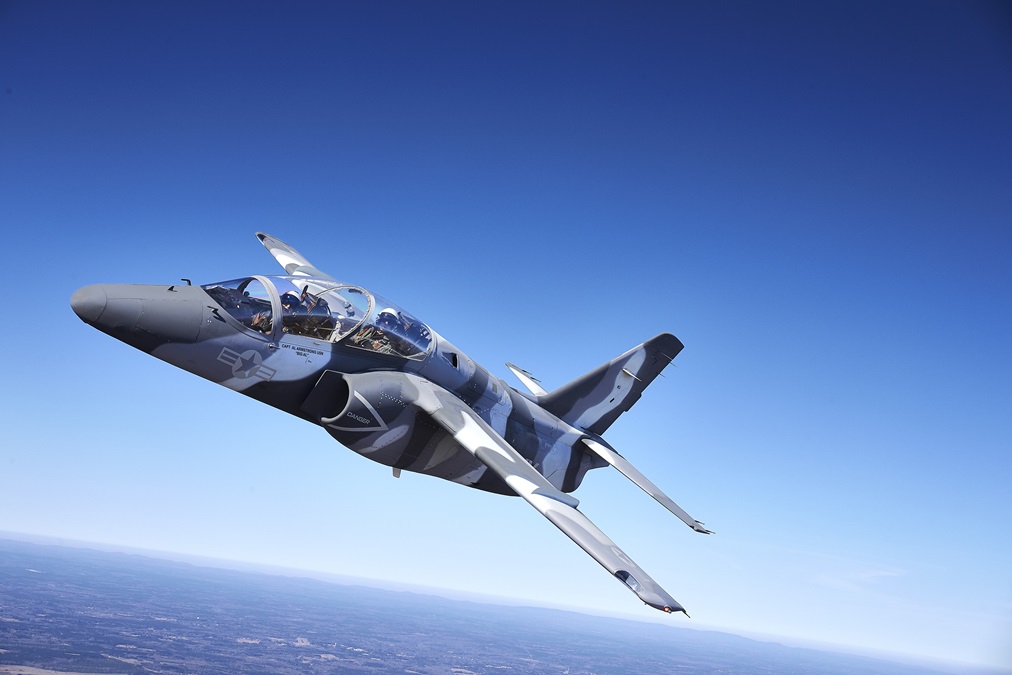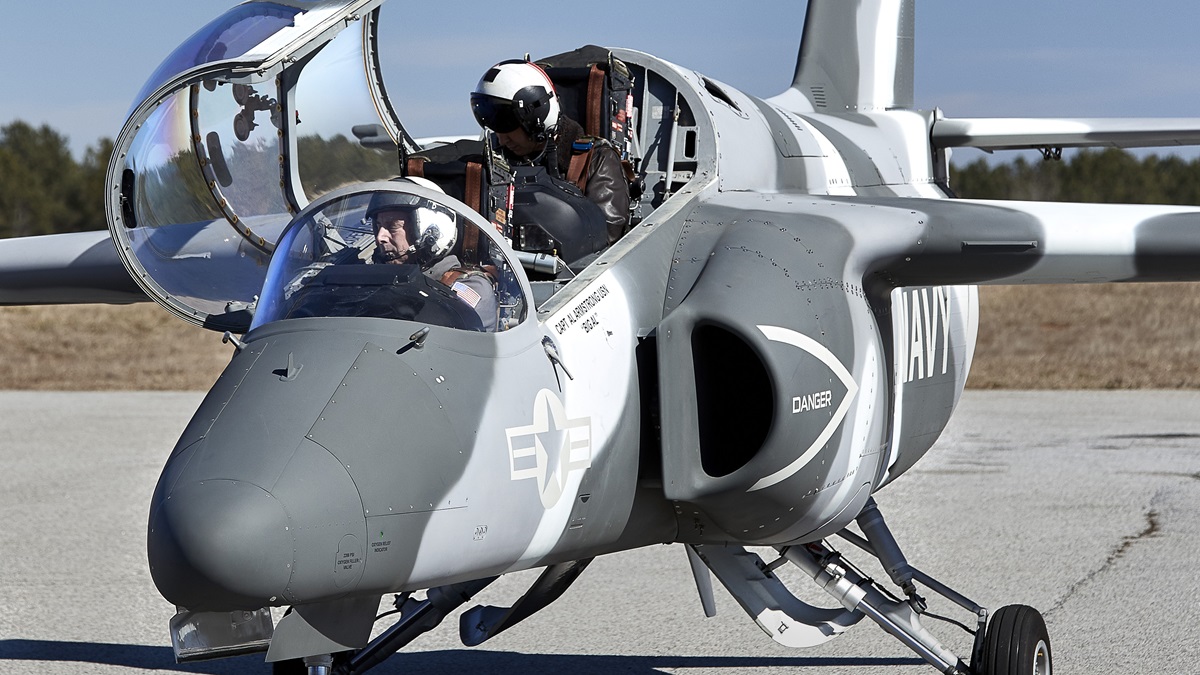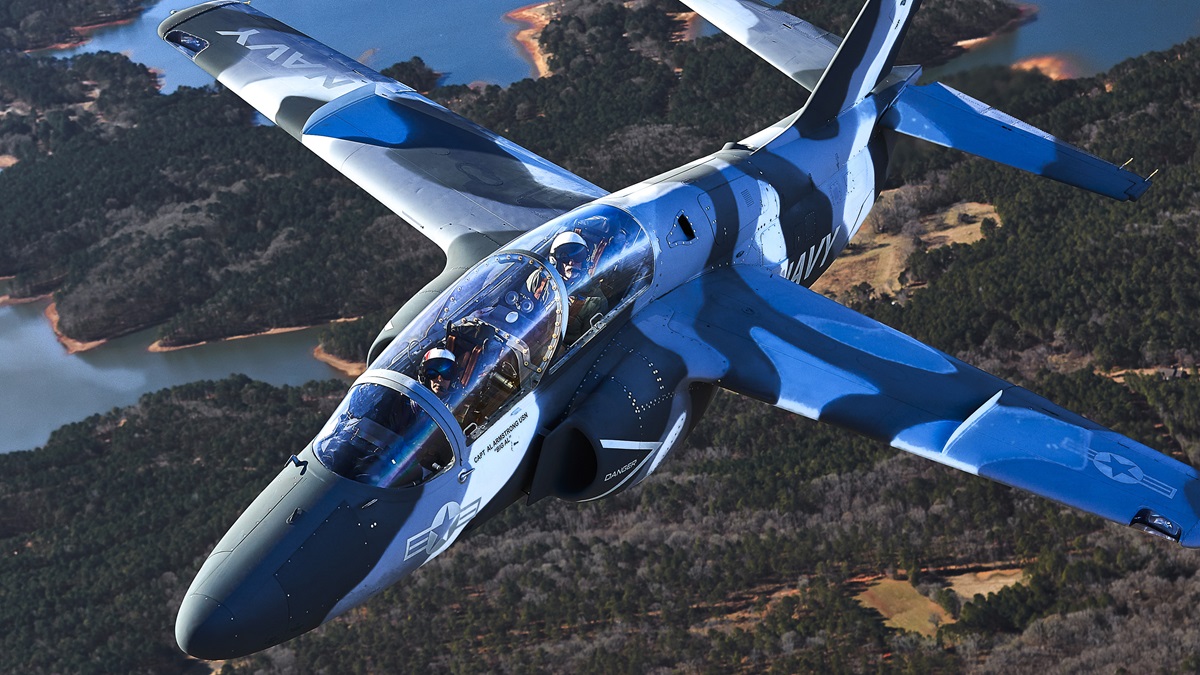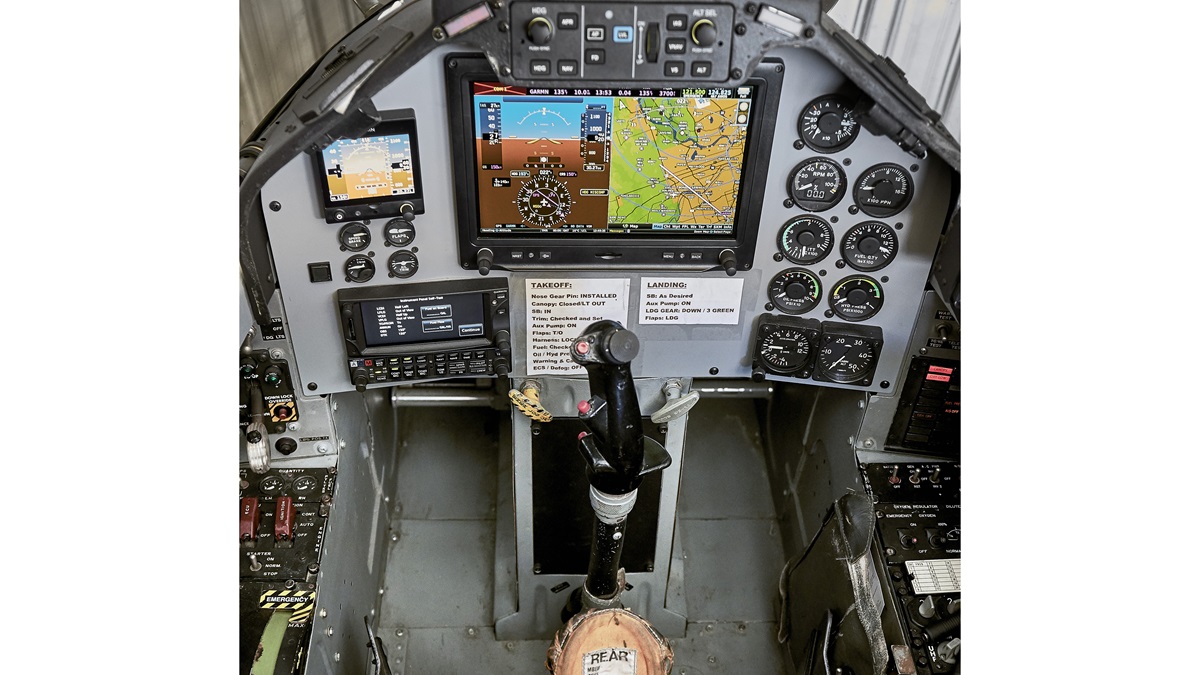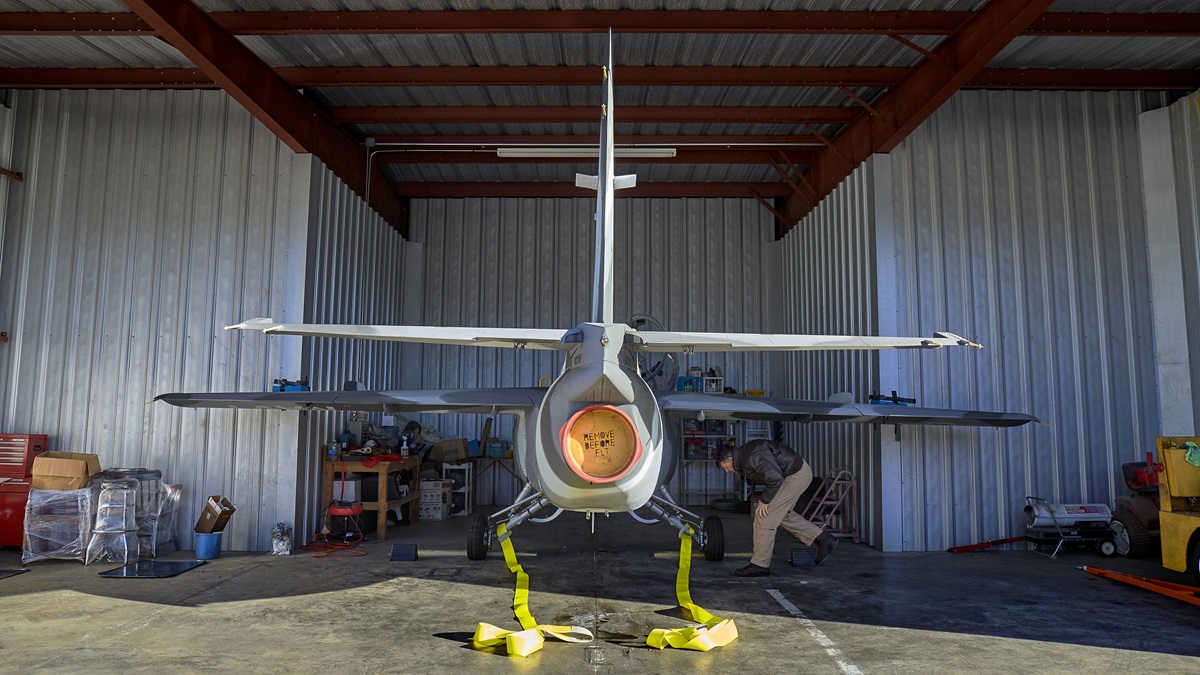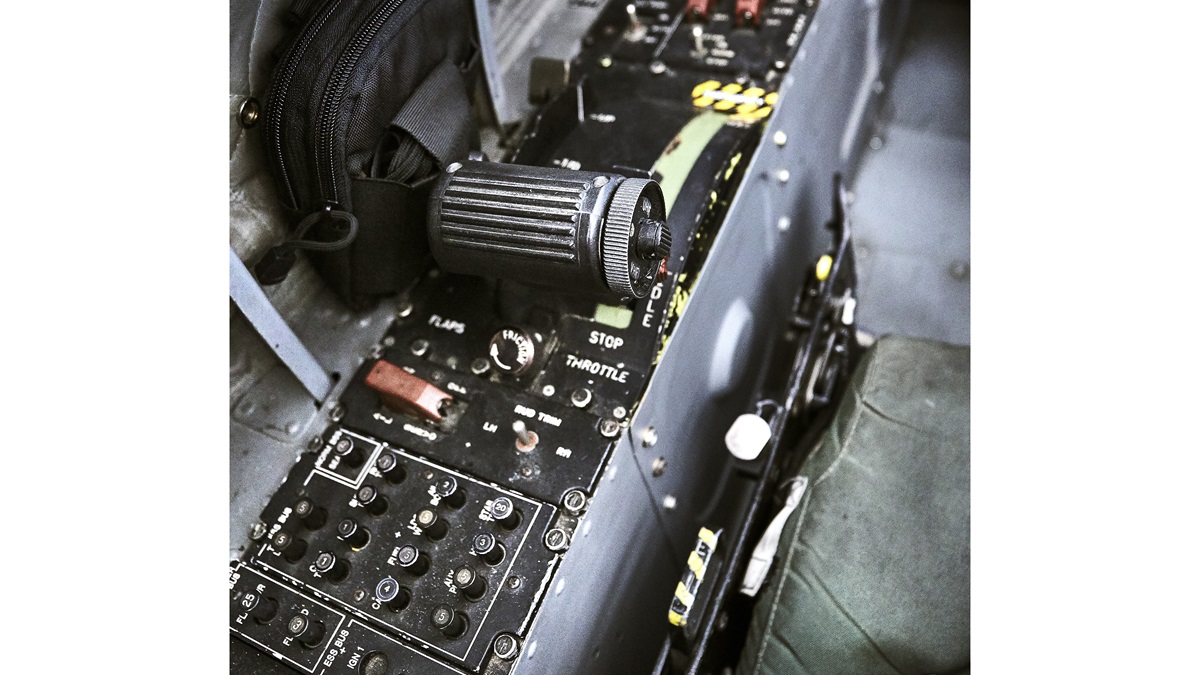The Italian job
Still nothing quite like the Marchetti S.211
The front cockpit of this exotic-looking Marchetti S.211 jet places the pilot go-cart low to the ground, and the white stripes on the runway centerline appear oddly gigantic because of their closeness. I do my best to keep them between my heels, but it takes some effort.
“The rudder’s going to feel like it’s got power steering—so don’t overcontrol it,” said Alan “Big Al” Armstrong, who bought and customized this stylish jet two years ago, and who is kindly coaching me through a demo flight.
Armstrong keeps his airplane in a T-hangar at the Henry County Airport in the shadow of the Atlanta Motor Speedway and he flies it to airshows and other events within its nonstop range of about 600 nautical miles.
Those runway stripes become a blur near the end of our 12-second, 2,200-foot takeoff roll. The two-seat aerobatic jet reaches its 95-knot rotation speed, and a tug of back pressure on the control stick lifts it off at 100 knots. Once free of the ground, the airplane’s rate of acceleration increases dramatically.
“Tap the brakes, then raise the gear,” Armstrong said. “And do it quick so we don’t blow through our gear and [takeoff] flap speed [of 160 knots].”
It’s a cool and sunny winter day in Atlanta with a surface temperature of 48 degrees Fahrenheit, and the Marchetti is climbing at 3,500 feet per minute. I’m holding a 15-degree nose-up attitude as the indicated airspeed flirts with 200 knots—the FAA limit under the Class B airspace veil. We turn south to get away from the airspace restrictions and become acquainted with this rare jet.
At 11,000 feet, the Marchetti is traveling 285 KTAS (240 KIAS) while gulping down about 105 gallons an hour of jet fuel—and we’re not even close to full power. It’s an inefficient altitude for fuel economy, but ideal for maneuvering. The view out the bubble canopy is expansive, and I search in vain for cues to aid my faulty pitch orientation. An attitude that looks to me like level is really a 10-degree climb. I’ve got to rely on the colorful Garmin G3X to find level.
“Feel free to roll it,” Armstrong said.
At 220 KIAS, the Marchetti’s roll rate is about 140 degrees per second, and full-deflection rolls to the left and right are complete in just under three seconds. Rolling maneuvers are delightful because the pilot sits at the center of the roll axis. It feels as though the horizon simply rotates around you in a topsy-turvy IMAX movie. There’s no sensation of being slung up and down, or from side to side.
Armstrong has logged thousands of military flight hours as a naval flight officer, mostly in E–6E Intruders and F/A–18 Super Hornets, and he helped develop and test new equipment after completing the U.S. Naval Test Pilot School in Patuxent River, Maryland.
“Everything about military jets is familiar to me because they were such a big part of my training and experience growing up,” said Armstrong, 50, a captain in the Navy Reserve. “That makes me extremely comfortable around them. I’m not talking about physical comfort—these seats get kind of hard after a few hours. I’m talking about the kind of comfort that comes from familiarity and experience.”
First VLJ
The Very Light Jet concept didn’t yet exist when Italian manufacturer SIAI-Marchetti developed and first flew its S.211 prototype in 1981.
The aircraft was designed as a military trainer and light attack aircraft, but it didn’t sell well, and only about 60 were produced when the assembly line closed in 1994. The Singapore Air Force was its biggest customer, and others went to the Philippines (which still flies them) and Haiti. Singaporean pilots trained in Marchettis in Australia, and by all accounts, the airplanes were extremely well cared for.
They were made from proven components, beginning with Pratt & Whitney Canada JT15D-4C engines—the same family as those found on Cessna Citation Is and IIs and many other business jets. Additional U.S.-made parts include wheels and brakes, batteries, and avionics.
Unlike some other military jets that require ground crews and extensive ground support equipment, the Marchetti can start using an internal battery (or external power), and no ladders are necessary to climb in or out of the cockpits. There’s also room to store a few duffel bags or other gear in an unpressurized cargo compartment in the belly.
Several U.S. firms and private individuals imported former Singaporean Marchettis around 2010, including Dee Conger, a former U.S. Air Force fighter pilot, who refurbished them in San Diego, California. Armstrong purchased an airplane that Conger had imported, then had Neal Aviation at Gillespie Field in San Diego install new Garmin avionics in both instrument panels. Classic Fighters of America in Titusville, Florida, added the three-color gray camouflage paint scheme.
About 20 Marchetti S.211s are registered in the United States under the Experimental Exhibition category.
Armstrong described his rationale for buying one as “only slightly delusional.
“I owned a turbocharged Beech Baron at the time, and on about 95 percent of my flights, I was solo or had one passenger,” he said. “The jet is a lot thirstier than a piston twin, but my cost per mile isn’t too different, and maintenance on the jet is a lot simpler than it was with 12 cylinders and two turbos.
“The word ‘economy’ doesn’t really come up when you’re talking about ex-military jets,” Armstrong said. “This one is about as close as you can get to an economical jet. It’s got similar performance to an L–39 [which Armstrong is also qualified to fly] at about half the fuel consumption.”
Armstrong typically flies at about 28,000 feet on trips of 150 nautical miles or more. There, the Marchetti travels about 310 KTAS at 75 gph. The pressurized cockpit typically has a cabin altitude of 12,000 to 14,000 feet there.
Like other jet pilots, Armstrong stays at high altitude as long as possible, then descends at idle and 150 KIAS for maximum range. With landing gear and flaps down, he aims for 140 KIAS in the traffic pattern, slowing to 100 over the runway threshold. The airplane has speed brakes for steep descents but they’re not necessary in the pattern.
The high-bypass engine has a quick throttle response, so there’s no turbine lag when adding power.
“You get a good response from this engine right off the bat,” Armstrong said. “If you ever need to arrest an excessive sink rate, or go around, the response from the engine is almost instantaneous.”
Strap in
Stepping into the front seat is a simple matter of putting your left foot in a recessed step, then swinging your right leg over the rail and onto the seat. Slither down into the deactivated Martin-Baker ejection seat and connect the serpentine seat belt harness. Cockpit dimensions are ideal for a 5-foot, 8-inch, 175-pounder like me, but if you played offensive tackle on your college football team, expect a tight fit.
The side-hinged canopy folds over and locks with a latch. Engine start is simple matter of turning four switches on (battery, generator, inverter, and normal bus), flipping the auxiliary boost pump to the On position, engaging the starter, and watching the engine rpm rise. Once it reaches 10 percent, advance the throttle to idle and monitor temperatures and pressures. Program the linked Garmin G3X and GTN650, and you’re ready to taxi. Steering is normal with hydraulic toe brakes.
The pretakeoff checklist is short: harness and canopy locked; speed brakes in; flaps to the takeoff position; auxiliary pump on; rudder, aileron, and elevator trim neutral.
Moving the control stick gives an odd, artificial feel on the ground. The elevator is light and the ailerons are heavy as they pull against centering springs. “You notice those things on the ground,” Armstrong said, “but it’s perfectly balanced in the air.”
Takeoff acceleration is steady, but with a total aircraft weight of 6,200 pounds (full fuel, two pilots) the engine’s 2,500 pounds of thrust doesn’t throw you against the seatback. Our takeoff roll goes from zero to 100 knots in about 12 seconds and covers 2,200 feet. Once off the ground, the Marchetti comes into its own, and a 15-degree nose-up attitude results in an initial climb rate of 3,500 fpm.
We accelerate to 200 knots in that attitude with the engine rpm reduced to about 95 percent (from the takeoff setting of 104 percent) on our way up to 11,500 feet.
There, steep turns are a video game that involves keeping the green G3X flightpath marker on the white horizon line. Slow flight requires reducing power to near idle in a clean configuration, then watching, waiting, and feeling for the rumbling onset of a stall buffet at 102 knots and a clean break at 99. Recovery is almost immediate with a slight reduction in angle of attack (forward stick) and power addition.
With landing gear and flaps down, the buffet and break take place at 90 and 87 KIAS respectively, and recovery is identical.
“The wing has a slight sweep to it, but it acts like a straight wing,” Armstrong said. “The airfoil is fairly thick, so it talks to you. It lets you know if it doesn’t like what you’re doing.”
Returning to the airport, the AWOS reported a seven-knot crosswind. We set up for a three-mile final approach to Runway 24 (5,500 feet) at 120 knots with landing gear and flaps down. I was slightly high at first, then caught the VASI glideslope and slowed to 110 KIAS at one mile. I added some power to keep the VASIs red and white, then wiped off the remaining power over the runway threshold and touched down at about 800 feet. With full back stick, the nosewheel stayed off the pavement about 10 seconds, then touched down on its own near midfield. Light to moderate braking was required to stop at the end. (The Marchetti doesn’t have thrust reversers.)
“The landing itself is quite conventional,” Armstrong said. “This airplane is a good trainer because, as you can see, it just doesn’t have any unpleasant idiosyncrasies.”
A league of its own
The Marchetti S.211 was a VLJ before that term was invented. It’s sleek, sporty, robust, and an absolute scream to fly—and costs about as much as a new Cessna 172 (although the operational costs are obviously orders of magnitude higher).
With so few produced, the Marchetti will always be a rarity. Know what it is and you’ll stump your friends at airshows and other flying events where you might encounter one. But the airplane also shows how much performance is available when a rugged, refined airframe is tied to a single turbofan engine.
JT15D engines started production in the early 1970s, so they can’t fairly be called modern. So, imagine a new FADEC jet engine paired with a light, strong, composite airframe. Cirrus has staked its future on that concept with its distinctive seven-seat SF50 Vision Jet, and it’s getting an enthusiastic reception in the marketplace. But the SF50, for sport fliers like me, has about five seats too many.
If anyone out there is interested in building an exciting, efficient, aerobatic jet, Marchetti paved the way a long time ago—and there’s still nothing else quite like it.
Email [email protected]

